I am pleased to present this email interview with the wonderful painter Susan Abbott.
From her bio:
Susan Abbott began her art studies under Richard D’Arista at American University. She graduated Summa Cum Laude with an BFA in painting from the Maryland Institute, College of Art, and received a MFA from the Institute’s Hoffberger School of Painting, with Grace Hartigan as her advisor. She went on to study printmaking in the graduate program at the University of Iowa under Professor Mauricio Lasansky.
Susan Abbott has been working as a professional artist since that time, exhibiting frequently in galleries and museums around the country. Her paintings are in many private and corporate collections, including Mead Data Central, the Gund Company, the Federal Home Mortgage Administration, Peat Marwick, and Chittenden Bank. Her commission for Oprah Winfrey was featured on the Oprah Winfrey Show.
Articles and reviews about Susan Abbott’s paintings have appeared in the Washington Post, Washington Times, Baltimore Sun, Artist’s Magazine, Washingtonian Magazine, Museum and Arts Magazine, Art New England, American Artist Magazine, Vermont Life, Watercolor Artist, and Watercolor USA.
The art critic for the Washington Post commented about Susan Abbott’s painting, “There simply aren’t many watercolorists in America who can match her level of expertise. What makes her painting so interesting, however, is the peculiar tension between the dazzling display of skill and the underlying idea.”
Critic Gerrit Henry wrote, “Each of her sublimely everyday epics is executed on a gargantuan scale…these paintings have a grave and gracious contemporary import.”
In addition to her career as an exhibiting painter, Ms. Abbott conducts art workshops in Italy, France, India, and the Bahamas, and locations around the United States. She lives in northern Vermont.
Larry Groff: Was there any early experience that taught you something in particular that is still important to you today?
Susan Abbott: My father was a painter and commercial artist, and my mother sewed, knitted, and embroidered. So I grew up with lots of inexpensive art and craft supplies in the house, and the time and space to draw, do needlework, and build stuff. No pressure or after school classes, just some encouragement and a little instruction if I asked for it from my parents. This private pleasure of making things with my hands has stuck with me since childhood.
By the time I went to the Maryland Institute, College of Art in the early 70’s I had some drawing and painting skills, but not much sense of what direction I wanted to take other than to work within realism. Eugene Leake was president of MICA during those years, and he had built a strong fine arts program that emphasized observational figure and landscape painting.
Leake brought in Israel Hershberg to teach, who wasn’t much older than we students were. That didn’t stop him from being very opinionated about how, what and why to paint. Grace Hartigan was my advisor in grad school at MICA, but I ended up spending much more time with Israel and the small group of students who had assembled around him. I loved what he was teaching us about the value of going directly to nature for inspiration, and then filtering that connection through what we learned from museum and art history studies.
I left art school feeling like I was part of a specific tradition of painting, a lineage that went forward for generations from Giotto to Piero, to Corot and Morandi, and on to Dickinson, Lennart Anderson and other contemporary painters. It was a narrow education in a way, but I’m very glad for it, because it gave me a secure grounding that then allowed me to continue on my own path.
That sense that I was part of an intimate circle of painters who share some common DNA, a connected family within an overwhelmingly huge and scattered art universe, has stuck with me since my time with Israel.
LG: In your podcast interview with Antrese Wood you talked about starting out in a time when a young painter could scrape by on very little and how that’s very different today. What experience might you share that would be helpful for young painters today trying to live life as a painter?
SA: My advice would be to learn to live on as little income as you can! Young artists need time, years of time, to experiment with imagery and ways of working. Growing often involves floundering, which can take awhile! There’s such pressure these days to have your “brand” figured out even as a student, to find a top-tier gallery right out of grad school, and then start turning out a saleable product.
When I buy a plant from the grocery store that’s been forced to bloom too quickly, it never seems to do as well as those I nurse along from seed. Those slow-growing flowers are the ones that are on my windowsill for years. Any great inventive modern painter you can name–Cezanne, Matisse, De Kooning, Diebenkorn–had years of slow growth and experimenting behind him before his work became known. Taking that necessary time to organically develop a voice and skills can be very difficult for a young person today. There’s such pressure not to fall behind in this competitive culture.
My son is a filmmaker in his 20’s, and I’m watching him get a foothold in his field. Not even factoring in the cost of his equipment, he has expenses for computers, cell phone, health insurance, and more that I didn’t have at that age. If you add in loans from college and grad school, it’s hard to see how anyone who’s not from a family with some means can make a start in the arts these days.
In the 70’s when I was just out of grad school, the U.S. wasn’t yet a full-blown consumer economy, and there wasn’t the pressure or need to own stuff like there is now. I could do an occasional calligraphy or illustration job, and live on that for months while I painted or traveled. These days you have to be very determined and single-minded, like my son is, to find time and space for independent creative work.
I can hear myself sounding like the old man going on about the miles and miles he walked to school when he was a boy, but I’ll say it anyway– I’m glad I went to art school at a time when students went for coffee to the seedy tavern down the block, rather than to a fancy student center with an espresso bar. Call me a curmudgeon, but does a college fine arts program really need all the high-cost amenities provided today? Maybe less expensive art schools with fewer bells and whistles would allow more talented young folks from more diverse backgrounds to follow their art dreams–and would provide a smoother segue to the real world of low income post-graduate living that most young artists will face. OK, rant over!
LG: How important is drawing to your work? Do you work out a careful drawing before starting a painting?
SA: Drawing is important to me, but I don’t make detailed drawing studies for paintings. That would remove too much of the surprise I like experiencing during the painting process. When working with oils in the studio, I’ll figure out a composition with gestural drawings in my sketchbook, and then begin the painting with a monochromatic underpainting where I fix the values and drawing. I’ll start working with color on top of that underpainting once it’s dry.
Outdoors I work more alla prima, drawing directly with color. But my watercolors begin with a fairly exact pencil drawing that helps guide the color washes. It’s just too unforgiving a medium to jump in with my brush without the net of a drawing underneath!
The contrast of a direct alla prima technique outdoors vs. a more indirect, slow, layered approach in the studio works well for me. Painting outdoors is exciting, it’s emotional, and engages all the senses. Plein air also helps me build a memory bank of light and color effects in nature. Whereas studio work is analytical, and allows me to construct a painting with more thinking and deliberation, a process I like. Plus, in my studio I get to drink tea, and listen to podcasts…
LG: How much does observation inform your work?
SA: Direct observation–in other words, “look and paint”, in that back and forth rhythm you get into, is how I start every painting. But then the painting itself takes over, and I become much more interested in what’s happening on the canvas. Usually this focus on the painting rather than my references involves editing something out (often it’s a something that I originally thought was the whole point of the painting), or adjusting color.
I usually begin a studio painting with sketchbook drawings, plein air studies, and photo references. The photos are black and white rather than color, and help me figure out the values and make the initial drawing. Photos don’t hold a whole lot of useful detailed information though; they just help with placing the main shapes. I rely more on memory and on-site studies as references.
I used to go back and forth on trying to figure out how to construct my paintings. It felt like a very big philosophical issue to me, and was exhausting (much more so than the actual painting) to try to decide whether there was a right and wrong way, a more honest and rigorous way, to build a painting than I was using–or whether that question even mattered.
I really respect the conceptual framework and discipline of artists like Antonio Lopez Garcia, Avigdor Arikha or Stanley Lewis who work only from direct observation. But at some point in each painting I seem to veer away and start to invent, either to try to salvage what I’ve got going, or because I’m excited about a possibility that’s developing on the canvas.
I fought that tendency to edit and invent for a long time, but I’ve finally accepted that whatever way a painter figures out how to get something down on canvas is ok. It’s a very personal choice, and the proof is in the pudding, in the power of the image.
And it is true that no painters are purely “perceptual”. Even those that rely only on observation are making many, many subjective choices as they “look and paint”. And they always end up creating an image that’s idiosyncratic, and recognizable as uniquely their own. Art really is smoke and mirrors, it’s magic. So I’m thinking now that it’s best just to keep practicing, and not second-guess my process.
LG: How do you decide on what is a good idea for one of your big paintings?
SA: Most of my larger landscape oils are inspired by the area around my home in rural Vermont. When I’m walking or driving I’ll see something that will give me that “aha!” kind of feeling, and I’ll stop and do a sketch of it, or take a photo from the car.
For example, I was going up to the Northeast Kingdom of Vermont near the Canadian border over the course of last year to work on a plein air project. On the way home at dusk I kept driving past an old gas station at the edge of a town. Something about the angles of the awning and the pumps, the muted blues and greys of the building, and the receding road behind it all just looked beautiful to me. Finally I pulled over one evening, did some drawings and an oil study, and I’m working on a large painting of that scene in my studio now.
Is an abandoned gas station on Route 2 at the edge of a depressed Vermont town a good idea for a painting? Well, I’ve learned I just have to trust the “aha!” moments when they come, they’re the only guides I have.
LG: You often use a bright, vivid palette, what role do you see color playing in your work? Which artists would you say most inspires your color sensibilities?
SA: Color wasn’t a big part of my training in art school. The sensibility of my teachers was more about subtlety and understatement, and using value rather than color to create a design. But I always had a love of decorative color, color for the sake of color, maybe influenced by all the sewing and needlepoint I did as a kid. I think painters (and whole periods of art history) are either more attracted to light and shadow, or more attracted to color shapes. I fall into the latter group. Working with color is a big part of the pleasure I get from painting.
When I started working more in watercolor than oils, my palette became brighter and edges became harder, and I started to think more about color design. Watercolor has the reputation of being a fussy, fuddy-duddy medium, but if you don’t water down the pigments too much, it’s capable of very intense, vibrant hues. Since my watercolor still lifes were imaginary compositions, I needed to also invent a color scheme. I started each painting with a palette of swatches of pure and mixed colors that were a roadmap for where I wanted the color design to head (which is something I still do for studio oil paintings.)
I have a wide range of pigments available, but all my paintings usually start with a triad that I’ll select depending on what I’ve got in mind for the secondary colors and color composition. I’ll add on more pigments to that painting’s palette as I need them. Other than for a monochromatic underpainting, I don’t use browns, greys or black, I mix all those neutrals.
When I teach workshops on color in art history, the painters I highlight are the ones I keep looking at myself for color inspiration: Giotto, Fra Angelico, Piero, Cezanne, Matisse, Gauguin, Bonnard, Morandi, de Kooning, Diebenkorn, Matthiasdottir, and many others.
LG: What is most paramount to get across to students in your workshops? What suggestions do you offer for the most common problems students tend to make?
SA: What I try to get across to students is how painting is both very complicated, and very simple. Complicated in that an experienced painter is making thousands of choices, starting with the subject, then the value composition, how much to define shapes, what’s happening at the edges of the format, mixing colors, and on and on. It’s an endless number of decisions that we get faster at processing as we paint more, until many choices become second nature, and stay consistent from painting to painting. I try to show my students how much more deliberation, struggle and courage goes into creating a painting than they might at first think.
But painting is also simple. It’s physical rather than metaphysical; it’s instinctive. That’s why little kids are so good at it. I think we all have an innate ability to make a world for ourselves out of a flat sheet of paper, if we can get out of our own way. Few people are going to end up professional artists, but many folks can have the pleasure of painting, and I think the world would be a better place if more did.
It’s very satisfying for me as a teacher when I see my students figuring out that painting is not just about skillfully copying what’s in front of them, that in fact what’s in front of them, what’s all around them in this world, is far stranger in angle, shape and color than most folks can see. Prodding students out of their safety zone to welcome this strangeness, this ability to perceive that the sky can be yellow and a tree purple, is the biggest help I can give them–and, paradoxically, results in them painting more accurately.
LG: In the past you’ve painted ambitious large watercolors of tabletop still life as seen from above. Much of your recent work is primarily landscape of some type. Why did you make this change and what directions do you see for your future work.
SA: I’m not sure if this is as true for other artists, and maybe it’s more true for women–but my living situation has often guided my work, rather than the other way around. After grad school I moved around a lot, and was painting small oils of figures, landscapes and still life, just trying to find my way. In my late 20’s, I came back to my hometown of Washington, DC, and had a studio again, so could paint larger. And I’d had a child, and found watercolor much easier than oils to take up and put down in the shorter spurts of time I had available. The still life were pretty intriguing to compose and paint, and it felt like a relief to have finally developed my own imagery and method of working.
Then I had another life change that changed my painting. After a decade in DC our family made a very impractical move to rural Vermont. It’s not an easy place to live because of few jobs and a long winter, but there’s easy access to nature here, a respect for history and the land, and it’s very quiet. (Just about the opposite of where we moved from.)
This time it took about five years for my work to catch up to my new surroundings. I wanted to get out of my studio and start painting this place I had fallen in love with, but it was a difficult transition back to landscape oils. It meant a permanent move away from a very specific image that I’d built some reputation for, and also that sold steadily. It helped smooth the transition that both the DC and New York galleries that exhibited my still life closed at around the same time, and that I won a grant to produce a series of Vermont landscapes that supported me for a year.
Such a big jump isn’t recommended career-wise, but I didn’t feel like I had much option except follow this new direction. I did bring along to the new oil landscapes some of what I’d been doing with watercolor still life, such as hard edges and strong color shapes.
I’m thinking ahead to paint figures and still life in oil again, as well as more of the kind of landscapes I’m doing now. So maybe I’ll end up painting the way I started, working with these three great realist subjects–all, I’m hoping, united by an individual way of seeing. The painters who pull that off, who don’t specialize too narrowly and keep experimenting, are the ones I admire the most.
LG: For some painters subject matter is of little importance compared to the formal concerns of a painting. For others the subject and narrative is the only reason for painting. What are your thoughts on this?
SA: It seems to me that narrative in a painting only works when it’s expressed by the formal aspects. For example, we read a mood of isolation and loneliness in Hopper’s work because of the ways he manipulates composition, like big foregrounds that set the viewer at a remove from the subject. In Piero’s “Legend of the True Cross”, the power of the narrative comes from the elegance and rightness of the shapes and colors, rather than the specific religious story Piero was commissioned to tell.
Visual art has it’s own language, just like music does. In music we can be moved by lyrics, or by a narrative subtext in classical music, but that wordy storytelling is always secondary to how music can make us feel with melody, interval, key–all the “formal” aspects of sound that set music apart from any other form of communication.
The same holds with painting. When painters try to tell a literal story without putting the formal language of visual art to work, it doesn’t end well. At the Louvre you can suffer through gallery after gallery of huge, lifeless canvasses commissioned by the church or government to tell very specific stories. Then you walk into the Poussin rooms, and you feel the power of narrative paintings orchestrated by a master of color, design and composition. It’s Poussin’s formal abilities, as well as genuine deep feeling for his subjects, that can make you cry looking at “The Plague of Ashdod” or “Massacre of the Innocents“.
LG: I’ve read about your recent Camino Walk, a 500 mile pilgrimage route across the top of Spain. Can you tell us something about this?
SA: I first heard about the Camino de Santiago eight years ago when I taught a sketchbook workshop in Galicia, and saw folks walking along the trail with backpacks, following the yellow arrows. I’ve always wanted to do a long trek where I actually get somewhere, so I started thinking about walking the main route, the Camino Frances across the top of Spain. Meanwhile my son Colin hiked from Mexico to Canada on the PCT, and he inspired me to quit dreaming about the Camino and commit to it, and also helped me figure out what to take, and how to travel light.
The Camino is actually a whole network of medieval pilgrimage routes across Europe that converges in Santiago de Compostela on the west coast of Spain. The people I met on the Camino from all over the world had many different reasons for being there–religion, adventure, escape, personal pilgrimage. My main reason to take a 500-mile walk was to follow my compulsion to do it, and to see what I’d learn.
The main thing I learned was that walking all day with a backpack makes me happy! Maybe we humans are built to be outside, to travel light, and keep moving. I’ve never felt as alive or free as during those two months of walking with everything I needed on my back. I’m hooked, and hope to do a long walk every year until I’m too old and feeble to put one foot in front of the other.
I brought along a journal, sketchbook, and watercolor block and kit, and stopped to draw and paint along the way. You can see so much when you’re walking. I also had the idea while on the Camino to do a series of larger oils back in my studio based on the varied landscape I saw as I moved across Spain, and I’m working on that now. Painting is helping me keep hold of the experience of the pilgrimage, and to keep learning from it.
LG: I see where you also paint in many other foreign locations. Can you tell us something about how travel has affected your work?
SA: Living in a rural area, I can get a little stir crazy sometimes, and I’ve been lucky that teaching has allowed me to get out every once in awhile and see new places, or return to favorite places. I’ve been going back for a few weeks every summer for the last twenty years to the same village in Provence to teach and paint, and really love the chance to work in that completely different, beautiful landscape. Same with the Bahamas, where I go every winter to teach–such different colors and different motifs from Vermont. A workshop in India inspired for me for a year after I came home–I just couldn’t get the colors and scenes I’d seen there out of my head, and ended up painting a series of twenty-five oils based on my trip.
All this travel and painting in different parts of the world can make me feel a bit scattered sometimes, too. I want to keep in mind what it is I’m trying to say with my work, and be careful that I’m not just reacting to where I am at any given moment. It takes some juggling, both mentally and with the calendar, to get a balance between the excitement of travel and being settled in the studio.
LG: I’m curious about your work with some other art projects such as your involvement with the Vermont “Art of Action” project. What more can you tell us about this and how important is being connected to your community as an artist for you?
SA: Small Vermont towns like mine are pretty much run by volunteers, but I’m sorry to say that I’m usually holed up in my studio or traveling to teach, and do very little in my own community to help out. The one local organization I give time to is the Vermont Land Trust. They’ve conserved almost 10% of land in the state, helping to keep our farms, forests, and wildlife habitat intact.
The VT Land Trust has a trustee seat for someone in the arts, and I’ve been on their board for the last six years. We recently organized a project called “Eyes on the Land” that paired fourteen visual artists with conserved properties across the state, and gave the artists a year to get to know their area, and produce a “visual essay” from their experience.
I selected a big wetland up on the Canadian border, painting forty 12″ x 12″ plein air studies there. I experienced this land changing through the seasons in that intimate way that painting gives you, and really came to appreciate the richness and beauty of wetlands. (Please don’t “drain the swamp”!) A project like this doesn’t have definite results, but it felt worthwhile for me to put the time into as it was good for the artists, helped get publicity for the Land Trust, and built some bridges between the cultural and conservation communities.
“Art of Action” was another state-based project I was involved in a few years back. A Vermont conservationist and art collector commissioned ten artists to weigh-in on the question of the future of Vermont. I’m not sure we came to any useful conclusions, but the project did provide a context for community involvement. Many Vermonters saw the exhibits and engaged in discussions organized around the art about how they wanted to shape their futures, what they liked about living here, and what they wanted to change.
LG: Your father was a painter who painted politically themed works during the 1930’s. You remarked on facebook that these were “inspired by what he had witnessed at peaceful protests by unemployed folks demonstrating for the things we take for granted now, like Social Security and unemployment insurance. It has me thinking about Standing Rock, where there are peaceful protesters being met with escalating force.” Your dad’s paintings remind me of Fairfield Porter’s early works when he used a similar subject matter, of course he abandoned this direction in favor of his more well known painterly realism. However he still remained an activist outside of painting and was particularly involved with environmental issues throughout his life.
With Donald Trump now our new President, is there a way for painters respond effectively with their art, or do you think that politics and painting is inherently a bad combination?
SA: Political painting, meaning painting whose main purpose is to make a political point, is a form of narrative painting, and I’ll go back to what I said in response to your previous question about that. I think painting is capable of much more than illustrating an idea, it can live on a different plane than the literal, and at its best is communicating in a non-verbal, powerful, mysterious language. I don’t think overtly political painting is existing on this higher plane, or even changes anyone’s mind about political issues–though it may lend helpful support to a movement, like my dad’s painting did for progressive causes during the Depression.
I do think painting can have a powerful social effect that’s often unintended, and impossible to predict. For example, a few humble 19th century British watercolorists influenced Constable and Delacroix to work outdoors and look at color in nature, and their work opened the door to Impressionism and Cezanne, and all the social and art movements that followed. Here in the 1800’s the Hudson River School changed the way Easterners thought about the West, and helped persuade the federal government to preserve land through a national park system. And landscape painters can fundamentally alter the way we experience a place–think how Corot affects how we see Italy, and how Monet and Hopper changed how we view France and the U.S.
Few of these painters were “activists” working for a political agenda, but they did have a powerful effect on their societies. But, from what I see, much of the “serious” painting these days doesn’t talk to anyone except art collectors and other artists up in the rarified stratosphere of the art elite. Like a lot of contemporary literature, much of the “important” visual art is germinated in academia, moves quickly into elite cultural and commercial venues, and never seems to filter down into the public consciousness.
I was often walking on the Camino with educated, professional Germans, and asked each of them if they liked Gerhard Richter or Anselm Kiefer’s work. Not one of them had any idea who these most famous of artists were! It was a good reminder that the big name painters we obsess over have absolutely no importance to most people outside of our very tiny, specialized field.
But getting back to your question about political art. I think that if we artists want to protest Trump’s policies, we can probably do it most effectively by actually protesting, rather doing paintings about protesting. Five hundred landscape painters chained to their French easels on Federal land, preventing its transfer from a protected wilderness to a private fracking site, may actually do some good!

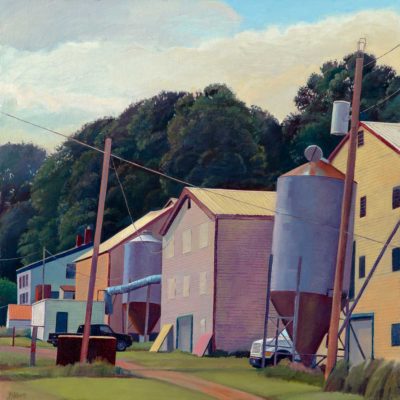
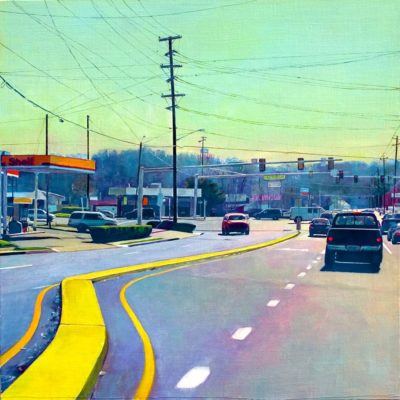
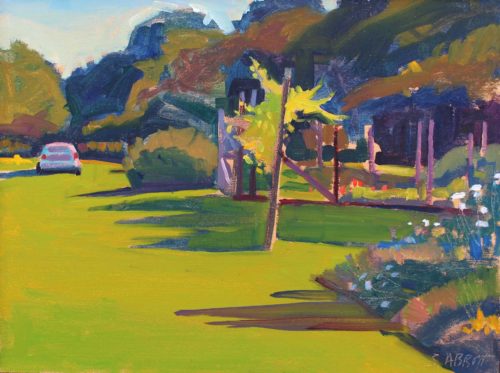
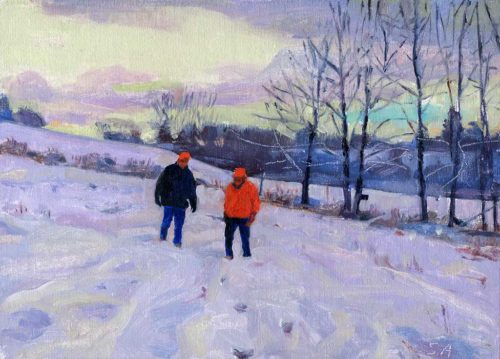
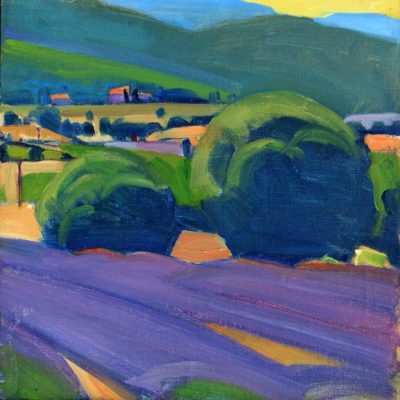
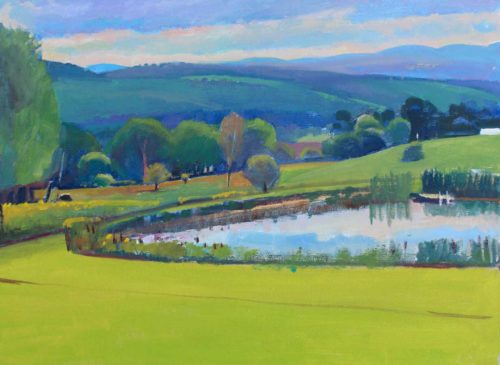
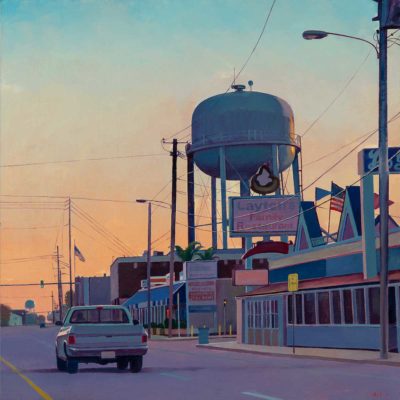
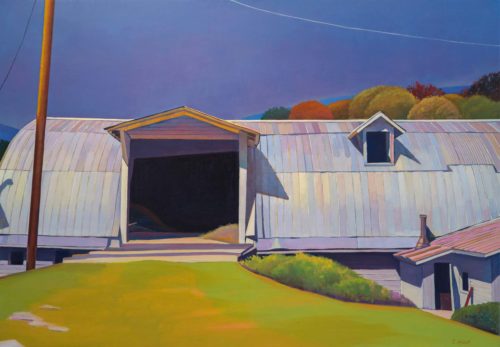
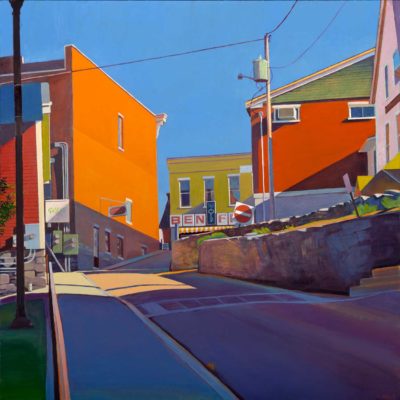
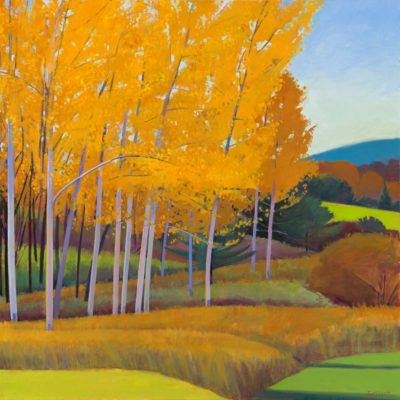

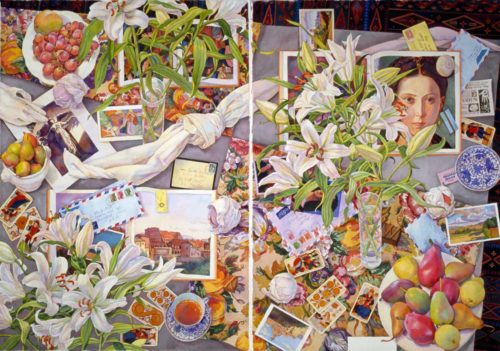
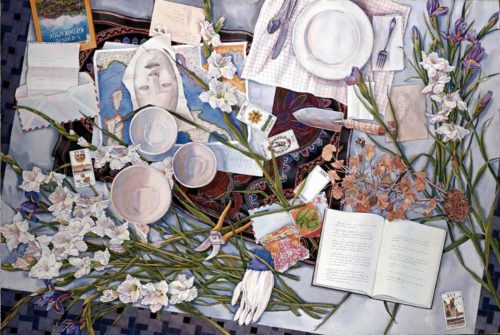
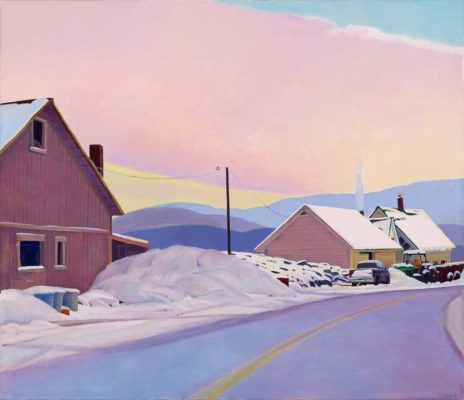
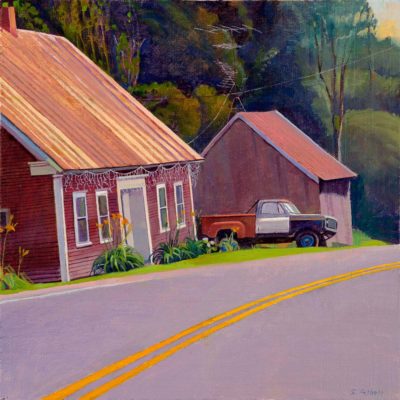
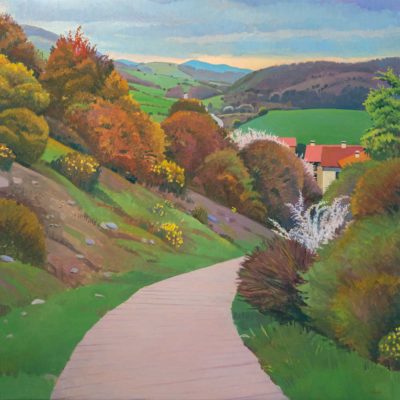
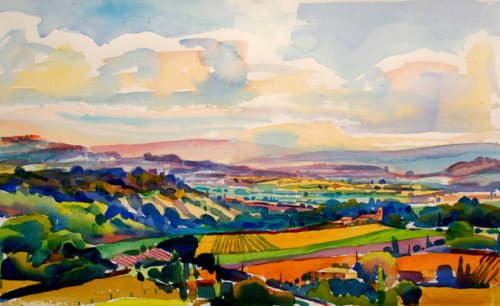
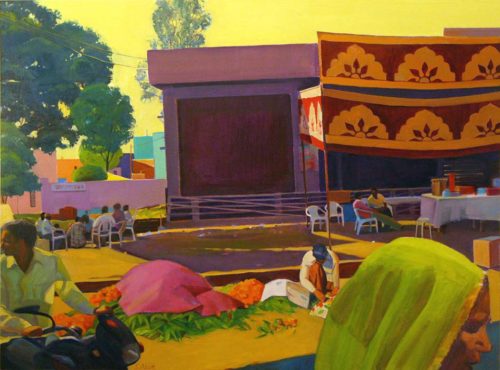
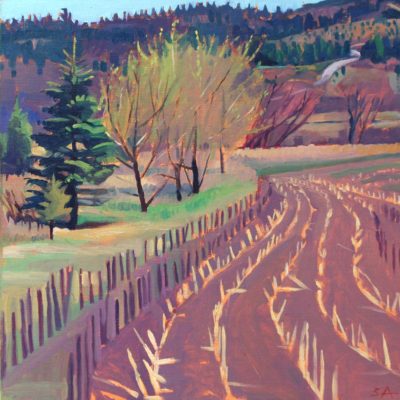
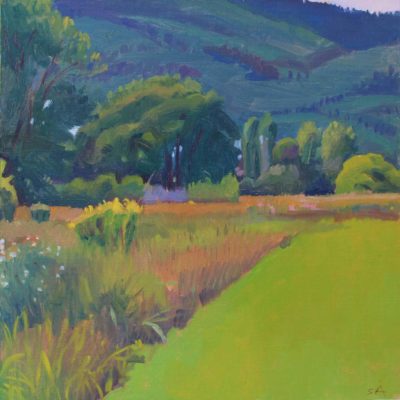
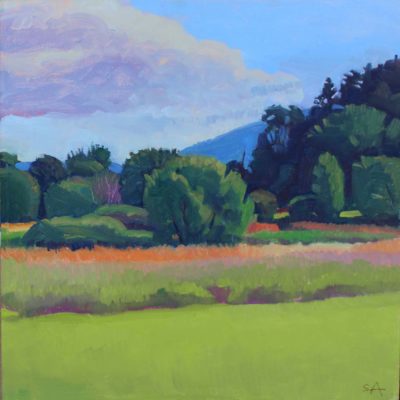
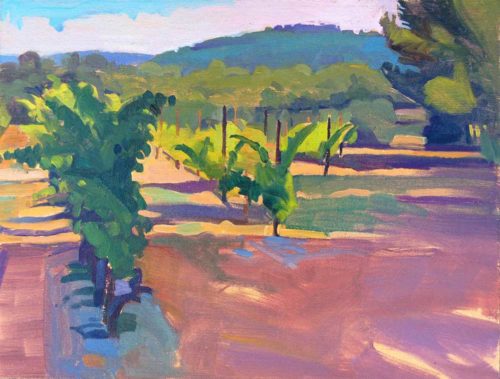
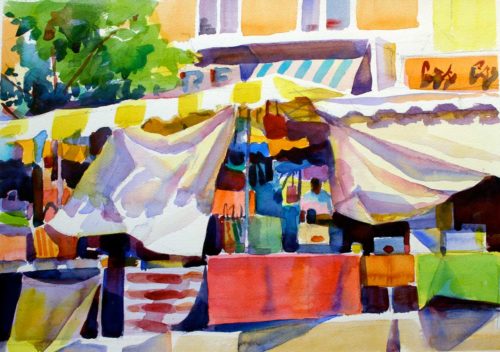




Great interview. Interesting to hear about Susan’s father and upbringing.
Interesting story about Susan, her art journey and her philosophy of life. I love her paintings, especially the landscape paintings. I think her paintings express a lot of what she’s all about. Excellent interview and well written narrative of her life. Thank you for show-casing her beautiful paintings… love the colors and compositions.
She’s probably right about chaining our easels together. Really, are we up for that?
Thank you for this insightful interview. I appreciate Susan sharing all of this and find it especially interesting to read about how her living situations impacted her work. I also really appreciate how she stresses artists need time to develop like those beloved house plants. Thanks for sharing your story and vibrant art with us!
Strong interview that talks as much about the perspective of living life as much as painting. But then are they really separate?!
I really appreciated this interview, and Susan’s groundedness.
I would like to recommend the Via Francigena to Susan and any other interested readers.
I have walked the section from Gran Passo San Bernardo in the Alps all the way down through Italy to St Peter’s Square in Rome.
Nowhere near as frequented as Santiago de Compostella but, for me at least, all the better for that.
And thank you for your valuable blog.
Susan, and her work, has been a strong influence on my own path as an artist over the past four years. She keeps growing in directions that catch my breath and inspire me to work even harder each day, honing my skills and seeing, with more clarity, my environment. Great interview! Thank you.